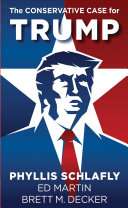The Conservative Case for Trump
The Conservative Case for Trump is a 2016 book by Phyllis Schlafly, a movement conservative best known for helping to defeat the Equal Rights Amendment in the 1970s.[1] It was her final book, being published posthumously.[2] The book was published in September 2016, following the nomination of Donald Trump for President of the United States, and explains in detail Schlafly's rationale for viewing Trump a serious conservative and a better candidate than Hillary Clinton.
 | |
| Author | Phyllis Schlafly |
|---|---|
| Country | United States |
| Language | English |
| Subject | Donald Trump |
| Published | 2016 |
| Media type | Print (Hardcover), Kindle E-book |
| ISBN | 978-1-62157-628-0 |
| ||
|---|---|---|
|
Incumbent
Presidential campaigns Controversies involving Russia Business and personal  |
||
The book, co-written by Ed Martin and Brett M. Decker,[3] describes Trump's anti-establishment stances on the following issues:
- bureaucratic regulations
- education
- family values
- illegal immigration
- judicial activism
- political correctness
- social security
- the U.S. military
- trade
One argument the book makes is that Republicans who do not support Trump would wind up helping to elect Hillary Clinton instead of him.[4] It also argues that Republicans and independents ought to "unify behind his candidacy".[5] (See Buckley Rule.)
The book's publication followed Schlafly's tussle with the board of the Eagle Forum after she unilaterally endorsed Trump's presidency.[1]
References
- Thorner, Nancy (September 7, 2016). "Thorner: 'The Conservative Case for Trump' Takes on Special Meaning with Schlafly's Death". Illinois Review. Retrieved September 25, 2016.
- "The Conservative Case for Trump". Regency Publishing. Retrieved 13 March 2018.
- Scott, Eugene (September 7, 2016). "When Phyllis Schlafly made the case for Donald Trump". cnn.com. Retrieved 25 September 2016.
- "This book by Phyllis Schlafly, Ed Martin, and Brett Decker shows why Republicans not supporting Trump are helping elect Hillary Clinton." —Laura Ingraham
-
"In The Conservative Case for Trump, Phyllis Schlafly, Ed Martin, and Brett M. Decker show how President Trump can get our country back on the right track, and why Republicans and independents need to unify behind his candidacy."—Newt Gingrich
.jpg)
